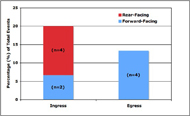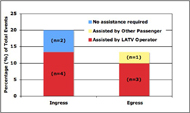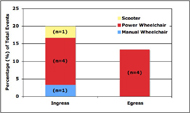Wheelchair Ingress/Egress Activities in Large Accessible Transit Vehicles
Sheryll Sison, BS, Karen Frost, PhD MBA, Gina Bertocci, PhD PE
RERC on Wheelchair Transportation Safety, University of Louisville Mechanical Engineering
ABSTRACT
There is limited information regarding usability and safety during wheelchair-seated passenger ingress/egress activities in large accessible transit vehicles (LATVs). We reviewed video recordings of 30 sets of ingress/egress events involving wheelchair-seated passengers using LATVs. There were 6 ingress and 4 egress events that involved difficulty or resulted in an incident. Factors appearing to contribute to these occurrences included ramp angle of incline (n=4) and ascending the ramp using a rear-facing wheelchair orientation (n=4). Assistance from another individual was required in 8 of 10 difficult events and incidents. These findings provide a foundation for future research regarding wheelchair safety and usability issues during ingress/egress on LATVs.
KEYWORDS
Wheelchair transportation, ingress/egress, large accessible transit vehicles
BACKGROUND
The 1990 Americans with Disabilities Act mandates that persons with disabilities be provided access to public transportation. This legislation requires public transit agencies to provide access to vehicles via lifts and ramps (1). Based on the 2002 U.S. Census Bureau Report, there are an estimated 2.7 million persons over 15 years old who use wheelchairs and/or scooters (2), many who require public transit as their primary source of transportation.
The National Highway Traffic Safety Administration (NHTSA) investigated the number of deaths and injuries to wheelchair users involving motor vehicles that occurred between 1991 and 1995 (3). This 5-year study used data from the National Electronic Injury Surveillance System (NEISS) and estimated 7,121 motor vehicle-related injuries/deaths to wheelchair users. Twelve percent of injuries/deaths resulted from bus-related incidents. In all motor-vehicle related incidents, 25% of injury producing activities were due to either wheelchair lift malfunction (19%) or falling on/off the ramp (6%). There were no fatal outcomes based on lift malfunction or falling on/off the ramp. More recently, Rotko et al. (2005) surveyed wheelchair users regarding injuries sustained during loading/unloading in both public and private motor vehicles (4). Of 86 reported injuries, 22 injuries (25.8%) occurred while using a ramp. However, the majority of respondents in this study traveled using private vehicle and paratransit; 9.8% used public bus.
Frost and Bertocci (2007) conducted a 4-year retrospective study of incidents involving wheelchair users on LATVs. Eighty-three incident reports for the period 2002-2005 were analyzed (5). The investigators found 73.2% of incidents occurred while the LATV was stopped. Perhaps more importantly, 59.3% of incidents occurred during ingress/egress. Sixteen injuries were reported; 75% of which involved the lift/ramp. Although informational, this study did not describe factors influencing incidents and injuries.
Thus far, limited information exists describing incidents or difficulty associated with ingress/egress on LATVs or factors influencing injury risk during these activities. Previous studies conducted by Shaw (2000) and Songer (2004) addressed the issue of wheelchair rider risk associated with motor vehicle use (6,7), but focused on factors contributing to adverse incidents during transit. In this study, we reviewed ingress/egress activities on LATVs by wheelchair type, ramp extension level, wheelchair orientation on ramp, and exterior surface terrain in order to assess wheelchair user difficulty or incidents.
METHODS
Video surveillance footage of wheelchair ingress/egress events on LATVs was obtained from the Transit Authority of River City (TARC) in Louisville, KY for the 4-month period June - September 2007. TARC operates 285 large public transit buses and serves 1.2 million people in the Louisville metropolitan area. TARC estimates over 200 wheelchair boardings per week (8). Posted notices inform LATV riders of the surveillance program. Twenty-three LATVs are equipped with GE MobileView III Video Surveillance System® (GE Security, Bradenton, FL). This system records digital video images at a rate of 30 frames/second with up to 640x480 pixel resolution (9). Each LATV is equipped with 4-5 cameras. One camera is directed at the front door to capture all wheelchair ingress/egress events. The camera view includes the front door, access ramp, and 3-4 feet outside the LATV. The video footage is logged to an interchangeable digital video recorder (DVR).
 Figure 1. Output of QuickWave software illustrating video footage of LATV using a 4-camera view setup. (Click for larger view)
Figure 1. Output of QuickWave software illustrating video footage of LATV using a 4-camera view setup. (Click for larger view) DVRs were viewed once per week using GE Wave Reader 3.1 viewing software. Once ingress/egress events involving wheelchair-seated passengers were captured, footage was analyzed using GE’s QuickWave viewing software. Figure 1 shows the output of the QuickWave software used for video analysis.
Data for the following ingress/egress variables were recorded: wheelchair type, weather condition (sunny, overcast, rainy, snowy, night), ingress/egress process time, whether or not the LATV kneeled, level of ramp extension (street level, sidewalk level), exterior surface terrain (smooth concrete, uneven concrete, dirt/grass, gravel, pavement), wheelchair orientation on ramp (forward-facing, rear-facing), whether or not assistance was required, who provided assistance (LATV operator, personal assistant, or other passenger), whether or not an incident occurred, and whether or not difficulty was experienced by the wheelchair-seated passenger. Incident was operationalized to include events in which the wheelchair tipped and/or the passenger fell from the wheelchair during ingress/egress, the wheelchair and/or passenger impacted the LATV door/frame or other external object while the wheelchair was in contact with the ramp,or a wheelchair component(s) fell/dropped off the ramp. Difficulty with ingress/egress was operationalized to include events requiring repeated maneuvers to properly align the wheelchair with the ramp and events requiring supplemental assistance (e.g. pushing/pulling wheelchair).
Descriptive statistics were used to characterize incidents and difficulty with ingress/egress events based on analysis conducted using Microsoft Excel 2004 for Mac® Ver. 11.0.
RESULTS
During the 4-month study period, 30 ingress and 30 egress events involving wheelchair-seated passengers were recorded. As shown in Figure 2, the most frequent wheelchair type observed during ingress/egress was a power wheelchair (73%). Twenty percent (20%) of events involved manual wheelchairs and 7% involved scooters. Eighty-seven percent (87%) of ingress/egress events occurred during daytime under “mostly sunny” weather conditions. Thirteen percent (13%) of events occurred during nighttime. There were no ingress/egress events during overcast, rainy, or snowy weather.
Ingress
The average time for ingress (excluding difficult events/incidents) was 5.39 ± 2.79 seconds. During all ingress events, the LATV kneeled. The ramp was extended to sidewalk level in 67% (n=20) of boardings, and to street level during 33% (n=10) of boardings. The surface terrain adjacent to the ramp was smooth concrete for 60% of boardings, followed by pavement (27%), grass/dirt (7%) and uneven concrete (7%). The most frequent wheelchair orientation used to ascend the ramp was forward-facing (n=21, 70%) versus rear-facing (n=9, 30%).
Incidents and Difficult Ingress Events
Six difficult ingress events were observed. Two events occurred during forward-facing ascent and 4 events occurred during rear-facing ascent (Figure 3). During both forward-facing ascents the ramp was extended to street level. Surface terrain was uneven concrete and pavement, respectively. During the first event, a passenger using a power wheelchair reached forward and grabbed the LATV door handrail to pull himself up and into the LATV. The second event involved a passenger using a scooter. After multiple failed solo attempts to ascend the ramp, the LATV operator provided assistance, pushing the wheelchair-seated passenger up the ramp and into the LATV.
 Figure 3. Wheelchair orientation on ramp associated with difficult events and incidents. (Click for larger view)
Figure 3. Wheelchair orientation on ramp associated with difficult events and incidents. (Click for larger view) Four difficult events occurred when the wheelchair orientation was rear-facing during ingress. The ramp was extended to sidewalk level and the surface terrain was smooth concrete for the first 3 events. The ramp was extended to street level and the surface terrain was pavement in the last event. In the first event, a passenger using a power wheelchair impacted the interior side panel of the LATV and had to realign the wheelchair while on the ramp by moving slightly down the ramp in order to successfully board the LATV. In the second event, a passenger using a power wheelchair experienced multiple failed attempts in aligning her wheelchair at the base of the ramp before achieving proper alignment. The third event involved a passenger using a manual wheelchair who, after 2 failed attempts to ascend the ramp, required assistance from the LATV operator to pull her wheelchair up the ramp. During the fourth event, a passenger using a power wheelchair had to realign the wheelchair while on the ramp by moving partly down the ramp and forward to clear the LATV doorway.
Egress
The average time for egress (excluding difficult events and incidents) was 4.72 ± 2.46 seconds. During all egress events, the LATV kneeled. The ramp was extended to sidewalk level in 67% (n=20) of events, and to street level for the remaining 33% (n=10) of events. The surface terrain beyond the ramp was smooth concrete in 63% of the egress events, followed by pavement (30%), grass/dirt (3%) and uneven concrete (3%).
Incidents and Difficult Egress Events
 Figure 4. Summary of assistance required during difficult events and incidents. (Click for larger view)
Figure 4. Summary of assistance required during difficult events and incidents. (Click for larger view) Three difficult egress events were observed involving passengers using power wheelchairs. The ramp was extended to sidewalk level in each event. Surface terrain was smooth concrete sidewalk (n=1), pavement (n=1) and uneven sidewalk (n=1). In each event, assistance was required to descend the ramp, and the person providing assistance guided the wheelchair-seated passenger down the ramp until the front wheels of the wheelchair were in contact with the exterior surface terrain. Figure 4 provides a summary of who assisted the wheelchair-seated passenger during difficult events and incidents that required help from another person.
The only observed incident occurred during egress. During this event, the ramp was extended to street level and the surface terrain was smooth concrete. A passenger using a power wheelchair drove close to the right edge while descending the ramp; driving the right front caster off the side of the ramp. The LATV operator assisted the passenger by tilting and pulling the wheelchair to the left to raise the caster back on to the ramp. The LATV operator then re-aligned the wheelchair and guided the wheelchair-seated passenger down the ramp. Figure 5 illustrates the percentage of each wheelchair type involved in a difficult event or incident.
DISCUSSION
This is the first study to characterize wheelchair-seated passenger LATV ingress/egress events. Ramps are an essential component of accessible transportation. NHTSA reported that 6% of injury producing activities involving wheelchair users occurred on ramps (3). In our study, the ramp extension to street level appeared to contribute to difficulty in 4 of 10 ingress/egress events, resulting in a need for assistance. During ingress/egress the angle of incline is greater when the ramp is extended to street level, and this increased incline may present challenges in maneuvering the wheelchair. Additionally, if too steep, a passenger not using a pelvic belt could fall from their wheelchair during egress.
TARC recommends that wheelchair-seated passengers ascend the ramp in a rear-facing orientation. A rear-facing orientation helps to maintain the center of gravity of the wheelchair-seated passenger on the uphill portion of the ramp and closer to the LATV, thus reducing the risk of tipping. In this study, rear-facing orientation was used by only 9 of 30 passengers, and 4 of these boardings were classified as a difficult event. We observed that wheelchair users encountered difficulty while either aligning the wheelchair at the base of the ramp, or maintaining proper alignment while ascending. This difficulty is likely due to the limited visibility experienced when navigating rearward.
In this study, surface terrain did not appear to play a substantial role in increasing difficulty or incident risk. However, this may be due to the limited sample size. Surfaces such as dirt/grass and gravel were encountered less frequently than smooth concrete and pavement.
Limitations of this study include that it was not possible to quantify the extent of LATV kneeling, and thus the ramp angle. Our data suggests that ramp angle is an important factor affecting usability. Next, the camera focused on the ramp was mounted above the LATV operator’s seat. The camera distance, combined with the video capture rate per camera (6 frames/second), limited the level of detail we were able to observe during each event. Lastly, our sample size was limited both in size and geographical location and thus prevents generalization of findings.
CONCLUSIONS
Further investigation of LATV ingress/egress is necessary. In our study, 16.6% of total ingress/egress events resulted in difficulty or an incident. A rear-facing wheelchair orientation used to board the LATV may increase the difficulty of wheelchair maneuverability during ingress. Increased ramp angle of incline led to accessibility challenges for the wheelchair-seated passenger. These findings may help transit providers enhance procedures and identify future training needs for LATV operators.
REFERENCES
- Americans with Disabilities Act (ADA) Accessibility Guidelines for Transportation Vehicles, Architectural and transportation Barriers Compliance Board (ATBCB), 36 CFR Part 1192, Federal Register, Vol. 56, No. 173. September 1991
- U.S. Census Bureau. Americans with Disabilities in 2002. Population Profile Report. 2002. Retrieved from, www.census.gov/population/pop-profile/dynamic/Disability.pdf.
- National Highway Traffic Safety Administration (NHTSA) National Center for Statistics and Analysis. Wheelchair Users Injuries and Deaths Associated with Motor Vehicle Related Incidents. Research Note. September 1997. Retrieved from, www-nrd.nhtsa.dot.gov/Pubs/97.850.pdf
- Rotko K, Songer T, Fitzgerald S, Karg P. Injury to Wheelchair Users as a Result of Loading and Unloading from a Motor Vehicle. Rehabilitation Engineering Society of North America, Annual Conference, Atlanta GA, June 2005.
- Frost KL, Bertocci G. Wheelchair Rider Incidents on Public Transit Buses: A 4-Year Retrospective Review of Metropolitan Transit Agency Records. Rehabilitation Engineering Society of North America, Annual Conference, Phoenix AZ, June 2007.
- Shaw G, (2000). Wheelchair rider risk in motor vehicles; a technical note. J Rehab Res Develop, 37(1), p. 89-100.
- Songer T, Fitzgerald S, Rotko K, (2004). The injury risk to wheelchair occupants using motor vehicle transportation. Annual Proc Assoc Adv Automotive Med, 48 p. 115-29.
- Personal Communication, Russ Rakestraw, Transit Authority of River City, Louisville, KY
- GE MobileView III Product Manual. GE Security, Inc. Bradenton, FL. Product manual online www.gesecurity.com/portal/GESDownload?ID=724&DID=12661&documenttype=Product%20Brochure
ACKNOWLEDGEMENTS
This study was funded by the National Institute on Disability and Rehabilitation Research (NIDRR) and the Rehabilitation Engineering Research Center (RERC) on Wheelchair Transportation, Grant #H133E060064. The opinions expressed herein are those of the authors and do not necessarily reflect NIDRR opinions. The authors thank TARC, especially Russ Rakestraw, Mike Todovich, and Barry Barker for providing access to this valuable data.
CONTACT INFORMATION
Sheryll S. Sison, Injury Risk Assessment & Prevention Laboratory, University of Louisville
Instructional Building - Room 110, 500 S. Preston Street, Louisville, KY 40292
(502) 852-0279, (502) 852-0390 (fax), sssiso03@louisville.edu

